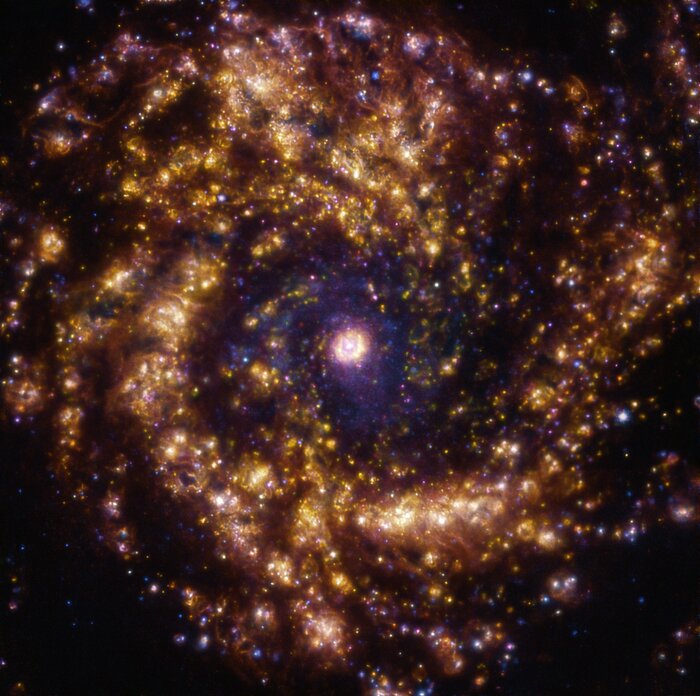The golden era to study stellar births
This week, we feature an image of the spiral galaxy NGC 4303, also known as Messier 61, which is one of the largest galactic members of the Virgo Cluster. Being a so-called starburst galaxy, it has an unusually high amount of stars being born, and has been used by astronomers as a laboratory to better understand the fascinating phenomena of star formation.
Stars form when clouds of cold gas collapse. The energetic radiation from newly born stars will heat and ionise the surrounding remaining gas. The ionised gas will shine, acting as a beacon of ongoing star formation. In this stunning and jewel-like image, this glowing gas can be seen as the whirlpool of gold: the direct traces of stars being born.
The golden glow is a result of combining observations taken at different wavelengths of light with the Multi-Unit Spectroscopic Explorer (MUSE) instrument on ESO’s Very Large Telescope (VLT) in Chile. Here gas clouds of ionised oxygen, hydrogen and sulphur are shown in blue, green and red, respectively. The observations are done as part of the Physics at High Angular resolution in Nearby GalaxieS (PHANGS) project, aiming to reveal nearby galaxies across all wavelengths of the electromagnetic spectrum.
Are you curious about how one goes from observations to an image like this one? Check out this ESO blog post that goes into it in more detail of the process.
Credit:ESO/PHANGS
About the Image
| Id: | potw2231a |
| Type: | Observation |
| Release date: | 1 August 2022, 06:00 |
| Size: | 885 x 880 px |
About the Object
| Name: | Messier 61, NGC 4303 |
| Type: | Local Universe : Galaxy : Type : Spiral |
| Distance: | 50 million light years |
| Constellation: | Virgo |
| Category: | Galaxies |
Wallpapers
Coordinates
| Position (RA): | 12 21 54.91 |
| Position (Dec): | 4° 28' 24.88" |
| Field of view: | 2.95 x 2.94 arcminutes |
| Orientation: | North is -0.0° left of vertical |
Colours & filters
| Band | Wavelength | Telescope |
|---|---|---|
| Optical OIII | 499 nm | Very Large Telescope MUSE |
| Optical SII | 673 nm | Very Large Telescope MUSE |
| Optical H-alpha | 656 nm | Very Large Telescope MUSE |

